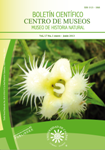Authors
Abstract
The present study analyzed the findings of helminths obtained during one year of coprological tests, in a captive fauna center in Colombia. Three hundred, seventy-five (375) coprological tests were made with samples collected from different species of amphibious, reptiles, birds, and mammals. The percentages of animals presenting helminths were as follows: amphibious 24%, reptiles 17%, birds 16%, and mammals 43%. The highest rates of parasitism for helmints were produced by geo-helminths, with a highest frequency for the strongylid groups (53%) and anchylostomides (33%) mainly in amphibious, reptiles and mammals. For 100% of positive birds Capillaria sp was reported and it was also found in mammals (7%). Helminths of lesser report were one acantocephalo, one cestode and three unidentified nematodes.
Keywords
References
BOTERO, D., RESTREPO, M., 1998. Parasitosis Humanas. 3ed. Medellín: Corporación para Investigaciones Biológicas-CIB,. p., 16-22, 89, 100, 405.
CAMPBELL, L.R., GAUGLER, R., 1991. Mechanisms for exsheathment of entomopathogenic nematodes. Int. J. Parasitol., 21:210–224.
FOSTER, G.W., CUNNINGHAM, M.W., KINSELLA, J.M., & OWEN, M., 2007. Parasitic helminthes of free-ranging mink (Neovisonvison mink) from Southern Florida. Journal of Parasitol., 93: 945-946.
HORNA, M., TANTALEÁN, M., 1983. Parásitos de primates peruanos. Helmintos de mono fraile y del pichico barba blanca. Bol. de Lima., 5: 54-58.
HOTEZ, P.J., BRINDLEY, P.J., BETHONY, J.M., KING, C.H., PEARCE, E.J., et al., (2008). Helminth infections: The great neglected tropical diseases. J Clin Invest., 118: 1311–1321.
HUGOT, J.P., 1985. Sur le genre Trypanoxyuris(Oxyuridae, Nematoda). III. Sous-genre Trypanoxyuris parasite de primates Cebidae et Atelidae. Bull. Mus. Natn. Hist. Nat., Paris, 4e sér., 7, section A No 1: 131-135.
IDEAM., INSTITUTO DE HIDROLOGÍA, METEOROLOGÍA Y ESTUDIOS AMBIENTALES DE COLOMBIA. Atlas Climatológico de Colombia. [En Línea]: Colombia: IDEAM, 2001. [Citado 10 de Abril de 2007]. Disponible en: http://www.ideam.gov.co
INGLIS, W.G., DIAZ-UNGRÍA, C., COLES, W.J., 1960. Nematodes de Venezuela. IV. Nematodes parásitos de vertebrados venezolanos, II. Acta Biol. Ven., 3: 1-24.
LENT, H., & FREITAS, J., 1937. Nova Physaloptera parasite de marsupial. Nematoda: Spiruroidea. Memorias do Instituto Oswaldo Cruz., 32: 221-223.
LITTLE, M.D., 1966. Comparative morphology of six species of Strongyloides (Nematoda) and redefinition of the genus. J. Parasitol., 52: 69-84.
SÁNCHEZ, N., MONTOYA, E., GÁLVEZ, H., ROMAINA, A., 2001. Parásitos gastrointestinales de primates neotropicales en cautiverio. Rev. Inv. Vet. Perú., 1:399-401.
SARMIENTO, L., TANTALEÁN, M., HUIZA, A., 1999. Nematodos parásitos del hombre y de los animales en el Perú. Rev. Peru. Parasitol., 14: 9-65.
TANTALEÁN, M., 1976. Contribución al conocimiento de los helmintos de vertebrados del Perú. Biota., 10: 437- 443.
TANTALEÁN, M., GONZALO, A., MONTOYA, E., 1990. Notes on some helminth parasites from Peruvian monkeys. Lab. Primate Newsl., 29 : 6-8.

 PDF (Español)
PDF (Español)
 FLIP
FLIP


















